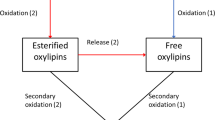Abstract
A knowledge of the mechanism of the degradation of triglycerides at temperatures from 190°C. is important in predicting the type of breakdown products likely to be formed in processing oils at elevated temperatures, or in the usage of oils and fats in frying or baking.
The effect of heat on tricaprin and 2-oleo-dipalmitin has been studied both in the absence and in the presence of oxygen. The results show that even a pure fully saturated triglyceride is rendered organoleptically unacceptable, due to breakdown in the temperature range studied, although the mechanism differs according to whether oxygen is present or not. Unsaturated glycerides are more readily degraded, fission at or near the double bonds being superimposed on the processes previously established for saturated triglycerides. Many of the degradation products have been identified.
Degraded triglycerides can be refined to an acceptable standard by conventional means but their keeping times, in the refined state, are considerably less than those of the original pure materials. Hence, it is inferred that precursors of off-flavors persist in the products and survive the refining operations.
Similar content being viewed by others
References
Chapman, D., Crossley, A., and Davies, A. C., J. Chem. Soc., 1502 (1957).
Krafft, F., Ber.,16, 1719, 3018 (1883).
Ralston, A. W., “Fatty Acids and Their Derivatives,” John Wiley and Sons, Inc., New York, p. 477 (1948).
Eckey, E. W., “Vegetable Fats and Oils,” Reinhold Publishing Corp., New York, p. 184 (1954).
Horikx, M., and Schogt, J. C. M., Grasas y Aceites,10, 115 (1959).
Kramer, P. J. G., and Van Duin, Rec. Trav. Chim.,73, 63 (1954).
Klein, F., and de Jeng, K., Rec. Trav. Chim.,75, 1285 (1956).
Coleman, J. E., Knight, H. B., and Swern, D., J. Am. Oil Chemists' Soc.,32, 135 (1955).
Claisen, L., Ber.,12, 626 (1879).
Holman, R. T., and Elner, O. C., J. Am. Oil Chemists' Soc.,24, 127 (1947).
Farmer, E. H., Bloomfield, G. F., Sundralingam, A., and Sutton, D. A., Trans. Farad. Soc.,38, 348 (1942).
Swift, C. E., Dollear, F. G., Brown, L. E., O'Connor, R. T., J. Am. Oil Chemists' Soc.,25, 39 (1948).
Ellis, G. W., J. Chem. Soc., 9 (1950).
Author information
Authors and Affiliations
About this article
Cite this article
Crossley, A., Heyes, T.D. & Hudson, B.J.F. The effect of heat on pure triglycerides. J Am Oil Chem Soc 39, 9–14 (1962). https://doi.org/10.1007/BF02633339
Received:
Issue Date:
DOI: https://doi.org/10.1007/BF02633339



